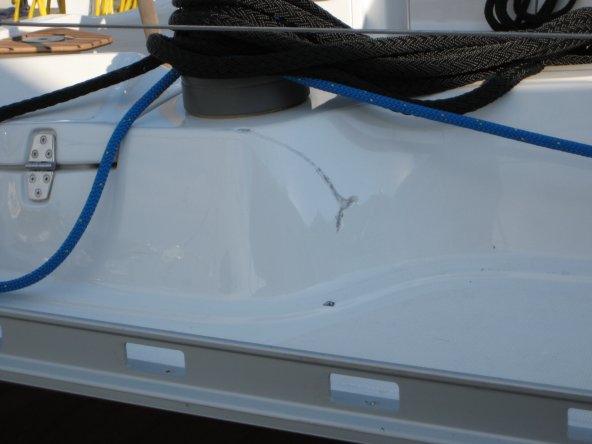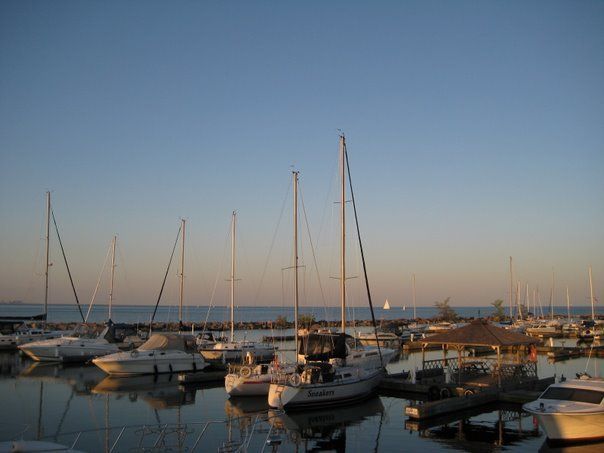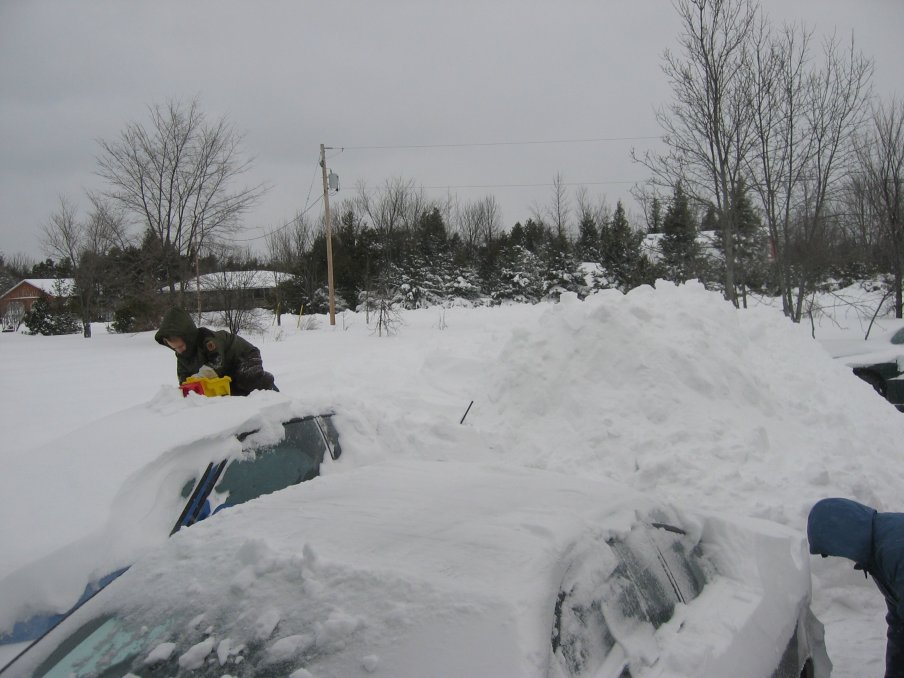-
Keeping Kids Safe on a Boat
We recently added another tool to the toolbox of keeping The Boy safely on the boat. He is now at the age (3 1/2) where he is curious, impulsive and wants to try and do everything. That means that, in a flash he can be o
 ut of the cabin and onto the deck of the boat. If he can fly out of here so fast, then we have to consider the possibility that he could just as quickly end up in the water. It worries me sometimes with A here and taking care of Baby Girl, that The Boy could get into trouble.
ut of the cabin and onto the deck of the boat. If he can fly out of here so fast, then we have to consider the possibility that he could just as quickly end up in the water. It worries me sometimes with A here and taking care of Baby Girl, that The Boy could get into trouble.So we bought him a turtle watch.
Actually, it is “Safety Turtle personal immersion alarm” that he wears on his wrist or ankle that will send a signal to a Base unit if it gets wet. i.e. falls in the lake. The base unit stays plugged in and is kept centrally in the boat along with one of the smoke detectors and the Carbon Monoxide detector. If the “turtle” gets wet, the base alarm sounds an ear-piercing siren that is loud enough to be heard anywhere around the boat.
So … it had it’s first ‘test’ the other day. The Boy was out on deck and all of a sudden the alarm went off. A. bolted out the door to see what was going on and found The Boy … licking his new turtle watch. Huh?! Yep, licking it. Nope, don’t know why. Anyway, now we know it works and only his wrist had to get wet to check it out.

Keeping kids safe on a boat is a topic that I’ve put a lot of thought into over the past couple of years. (Other post here.) I always seem to come back to the concept of Vigor’s Invisible Black Box. Check out the post Safety at Sea from a couple of years ago for a description of VIBB. Every time you envision what could go wrong and then plan for it, you are adding another piece of equipment to your VIBB. Safety, not just at sea, but generally in life is a combination of awareness and small corrections. Awareness of what could go wrong – awareness of something that is going wrong and then the small corrections to prevent or stop that situation. Of course, I’m not saying that disaster will not strike, but with planning and awareness you can prevent the series of small events that lead to catastrophe.
 Safety is a state of mind – it is living fully aware.
Safety is a state of mind – it is living fully aware.John Vigor wrote an article for Good Old Boat about the Black Box theory – check it out, it’s an interesting read.
Finally – every boater who ever leaves the dock should have John’s book, Seaworthy Offshore Sailboat: A Guide to Essential Features, Handling, and Gear
. Even if you have no intention of going off-shore, the concepts and planning will help keep you safe anytime you are out on the water.
-
Take Care of Your Bow
Docking Lesson No 1: When maneuvering your boat in strong winds, always be aware of your bow. It is the lightest part of your boat and is usually the furthest point from you and easily forgotten when looking for your slip or trying to set up your dock lines. Like the children’s song says, “When the wind blows, the bow will break,” (I know – it’s bough) and before you know it, the mad scramble begins to try to regain control of it and ultimately your boat.
On Sunday our neighbour went out in his beautiful (and new) Delphia 33. Beautiful boat! The sun was shinning, the wind was blowing a good 20 knots – basically a great day for a sail. Getting back into his slip became the tricky part. His plan was to back into his slip with the wind blowing straight down the slip. His initial approach was perfect – he came slightly past his slip, jammed it into reverse and with the wind blowing the bow to line up the boat began to back in. This is where he made his first mistake – he had the wheel turned the wrong way which made his boat go sideways instead of backwards. Back into gear and pull forward – no problem yet. Then he made his 2nd mistake (and the more costly one) instead of turning straight out into the channel and realigning the boat to back up for another approach, he just went forward a short distance and then tried to reverse back into the slip again. Only now because of the wind, prop-walk and momentum he was no longer lined up with his slip. Back into forward again, but now it was too late. The wind had caught his bow and swung him straight out, so that when he went into forward he was going straight at the boats in their slips on the dock across the channel. He tried to correct with hard port rudder and more gas but the bow was too far gone. CRASH. After unhooking himself from the boat anchor that he was hung up on, he went down the channel a ways and then reversed into his slip perfectly.
However, the damage was already done.
Some tips when working in a wind:
- Use the wind to your advantage. Be aware of exactly where the wind is coming from. Use your experience to know what that wind is going to do to your boat and then use the wind to your best advantage.
- Sometimes when the wind is blowing, it is easier to just go in bow first rather than losing your momentum and stability in the wind by going into reverse. It is far more fun coming back tomorrow to switch your boat around than doing repairs (and paying for other boat repairs.)
- When trying to dock directly into the wind, reverse might be the best option. Your bow will simply follow where you go – the wind will keep it in line – you don’t have to hardly even think about it anymore.
- When everything goes to crap – simply pull out – go down the channel a ways – catch your breath, and then get everything lined up for another shot. The reverse – CRAP … forward hard – reverse again – AH NOOOO … forward will full gas scenario is not what you want. If you bung it up, start over.
Maybe humming Rock-a-bye-baby will help you to Take Care of Your Bow.
- Rock-a-bye baby, in the water channel,
- When the wind blows, the boat will rock,
- When the bow breaks, the boat will crash,
- And down will go baby, bow and all.
-
Lightning Strikes Again (and again)
This past couple of weeks have brought us some absolutely spectacular lightning shows. Lightning with a thunder accompaniment always brings thoughts of safety (and fear) to mind. In a previous post about lightning safety, I managed to ease my mind by convincing myself that the higher masts around us would protect us from a strike. However, the truth of the matter is, if lightning would have struck our sailboat, there is no telling where it would have ended up. Our mast was deck stepped (the bottom of the mast sits on top of the deck, instead of going right through to the keel), which means that any lightning strike coming down the mast would have had to jump somewhere to continue its downward path. This is how holes get blown in the bottom of boats. Add the fact that the mast was practically sitting directly over our heads when we were laying in the v-berth and, well … you get the picture.
So now we are in a big metal boat; a big, highly conductive surface directly connected to ground (water), with a nice high metal canopy framework begging for a lightning strike. So am I really any safer?
I asked around the marina, and for the most part, people did not think that the metal boat would be safer – but then I came upon another boater who lives on a steel sailboat. He’s got the full deal going for him – a nice high metal mast and a highly conductive steel surface connected directly to ground. What he suggested is that we are actually safer in our steel shells because (in theory) the lightning strike should take the path of least resistance and flow easily and directly through the hull and into the lake. He likened it to a Faraday Cage.
Here is a quote from Wikipedia:
Cars and aircraft. When lightning strikes an aircraft or a car the electric currents induced on it are forced to travel on the outer skin of the vehicle’s body. If you were in a car, and the car were struck by lightning, it is not in fact the rubber tires that would save your life. If the lightning can jump from the ground to the sky, then it can jump from the ground to your car. What actually happens, is by being enclosed by the car’s cabin, the lightning travels around you, through the conductive frame of the car. This is because the car forms a Faraday Cage.
This is talking about cars and aircraft, but from what I can tell should also apply to boats. Anyone out there want to confirm this for me? Any modern day Franklin’s or Faraday’s want to experiment with this? (Go fly a kite!)
(Lightning Hitting CN Tower photo’s taken by Mathias Roussea on June 5th, 2008.)
-
Spring Update – The View from Here.
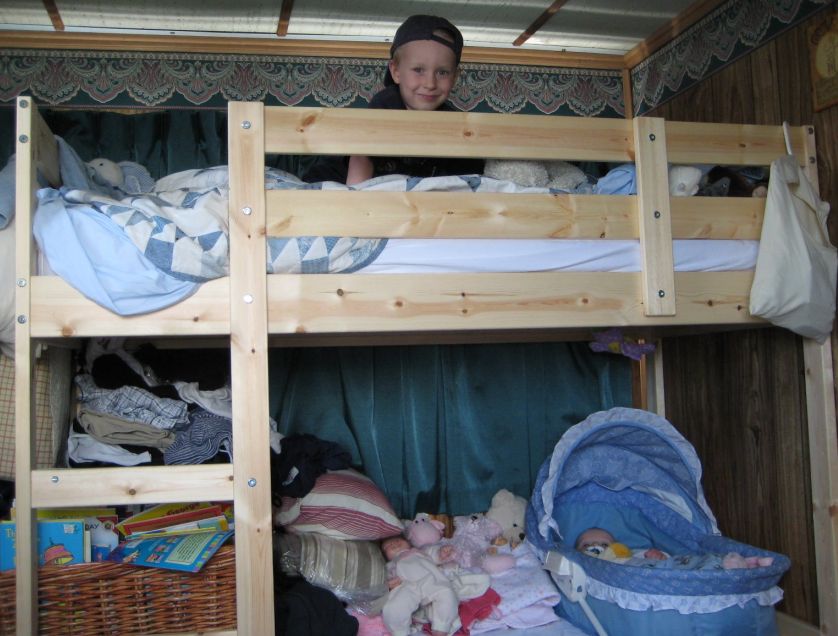 Wow – where has the time gone? Time does fly when you’re having fun!
Wow – where has the time gone? Time does fly when you’re having fun!Couple of updates first: the plastic wrap is off the boat and everything is ready for the summer. The engines started easily, the genny runs well and the AC units are both pumping out the cool when the days get hot.
Last week while A. and the kids were visiting grammy, I built bunk beds for the kids. The boy LOVES his upper bunk. He’s got all his stuff up there and loves climbing up and down. Plus he’s discovered a new game – when I’m laying on my bed, he crawls up into his bunk and starts throwing his stuffed toys at me while laughing his head of hysterically. At least one of us is having fun.
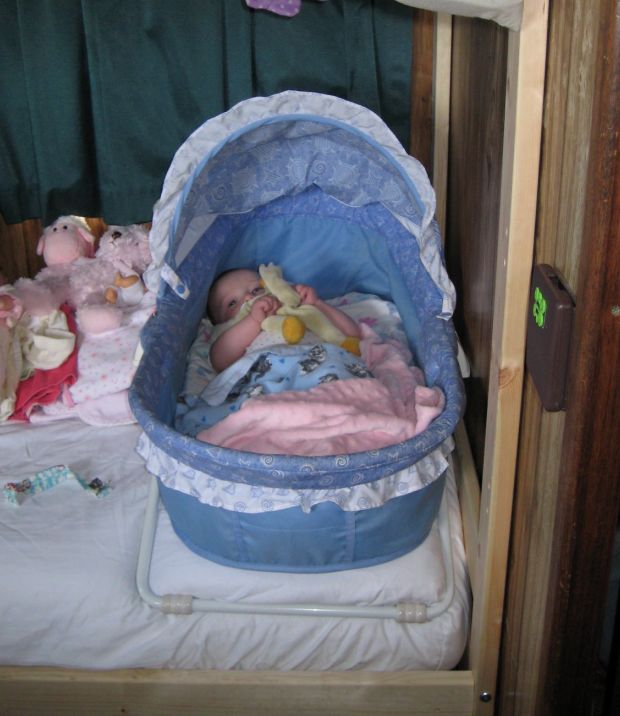
The girl is now 6 months old and growing like a weed. In fact she is in the 96th percentile for her length and her weight is off the chart. She’s still breastfeeding so I guess that is agreeing with her. She’s not mobile yet, but can roll over both ways, sit up by herself and jump like her pants are on fire in her exersaucer. That thing takes up a lot of space on a boat, but she loves it and the exercise is good for her chubby little legs.
I’ve begun to use the upper deck for my office in the evenings. The view from here is lovely but is more conducive to daydreaming than getting any actual work done. The weather has really warmed up, but is not too hot… yet. I will take advantage of my upper office as long a I can before the heat drives me back into my main floor office (kitchen table.)
I’m on the hunt for a dingy with a motor that the boy and I can tool around in this summer. If you know of any, let me know via email.
-
Signs that Spring is Here.
It began a couple of weeks ago with the arrival back of the seagulls. There was still a bit of ice here and there in the harbour which the seagulls used to conference on. Shreeking and calling at all hours of the night carrying on like drunken weekenders on a Canadian long weekend.
Next the brokers broke out of the winter funk and began to launch boats. It started with just one or two but now there are dozens of brand new sail boats lightly bobbing in slips without masts or the character that comes from use.
And now finally: water! It’s kind of funny – we live on water year round but miss it so badly when the supply gets shut off in the fall. Yesterday, we officially welcomed spring by taking a long hot shower on-board, wasting water and generally reveling in the luxury.
The final step in the spring dance will be the removal of the plastic. We’ve already cut some air holes to let out the heat during the day but in the next week or two we will go at it with razor knives and expose the River Queen in all her glory.
Tonight the moon was floating in the sky over Ridgetown – the water is still and the air is warm – harbingers of the days to come.
-
Boats and Computers
I suppose that most would consider our little family to be fairly computer literate. We have high speed internet on the boat which we access with 3 laptops and one Internet Tablet. We run a couple of personal blogs (WeLiveOnABoat.com, LifeAboard.ca) and two comercial sites (NeighboursAppliance.com, ScrapScene.com.) We use things like Skype (long distance phone calls) all the time, do our banking on-line and plan our days and lives with on-line tools such as Google Calendar and Remember the Milk. We use xDrive for our on-line backups.
I’ve been asked several times how get get internet on the boat. We have used 3 different internet suppliers here.
The marina where we are docked have a company that supplies wireless internet (for a fee) to the boaters in the bay. Their speeds are really good, especially the 2 meg uploads but their signal fades badly in various places around the marina including our winter slip here. I can use their access point in the front of the boat, but not in the back.
I also have an ‘air card’ that plugs into my laptop that I use primarily on the road at work. The speeds are Ok but not good enough for Skype – perfectly fine for basic surfing and email though. We use this connection when our other supplier is down.
Finally, our main internet supplier is a wireless modem unit called Rogers Portable Internet. The speeds are good to great for downloads but uploads can occasionally be a bit slow. It works good for Skype voice but can occasionally drag a bit on Skype video. We have it shared with a wireless router so that we can all be on the internet at the same time. (The Boy even has my old laptop which he uses to watch Bob the Builder, etc. videos on YouTube. He can pull his laptop out, turn it on and surf (via bookmarks) to his YouTube videos. He’s 3 yrs old…)
Others have expressed concerns about the moist environment on a boat being bad for computers. We have not experienced any problems with this while on board unless you count dropping a water bottle on one of the laptops shorting out the keyboard – oops. For the most part, laptops today seem to be fairly durable. The one I am writing on right now is 2 yrs old and travels with me in my service truck everyday. That means vibration, dust and constantly being slapped around and it is still working fine. Of course, tomorrow it will quit! I guess what I am saying is that we’ve have had good experiences with laptops on our boats.
-
Winter Snow Storm
Whew – we just got whacked again! On Friday we bundled up the family and headed off to my mother-in-laws home somewhat south of Ottawa. We arrived just as the snow started. It finally stopped snowing early this morning (Sunday.) Then the work began.
The first picture is of the snowplow stuck in the driveway. He to be towed out. That’s our car buried in a drift to the left of his truck.
The second picture is The Boy playing on top of the cars in the driveway. Cool, eh?
Again – I have to say it … where is that global warming everyone keeps carrying on about?
-
Visiting Snowy Owl
“Now there’s something you don’t see every day!”
As I stepped off the boat to goto work (late, as usual) this big boy was sitting on an ice flow just behind the boat. While I went back in to grab my camera, he took up a perch on an electrical box on the dock across from us. I’m not sure how common Snowy Owl’s are here, but this is the first one I’ve seen in 17 years here in the GTA (Greater Toronto Area.)
Any ornithologists out there? How common is this bird in Toronto?
-
Goodbye Blue Sky
After a couple of months of slowly sliding into a quasi winter-like condition, good old man winter stepped into his office this week with the resounding orchestral boom of thunder and strobing, pulsating flashes of lightening. The rest of the office staff: icy roads, windshield wipers that leave salt stained streaks and snow spilling over the top of boots everywhere, came brown-nosing along for the ride. A blurring whirlwind of activity culminating in frozen ear tips, cracked lips and cheeks stinging from the bite of ice pellets. Winter is here. Ta-daaa.
I grew up in great plains of central Canada. An area where the only thing stopping the wind was the occasional scraggly line of trees called, funny enough, a wind break and where we were taught that hills and mountains were bad because they block the view. Those flatlands experienced regular and spectacular winter snow storms; storms of fury that would dump 3 or 4 feet at a time accompanied by -30 or -40 degree temperature’s. The winds, back then, often took on pentecostal personalities of their own, groaning and howling with rousing power, shaking the house through the night. As a kid I put up with the manic whispers in the storm, knowing that the more tongues I heard spoken, the more likely there would be no school the next morning. Those were normal winter storms – the kind that everyone would talk about until the next one came along. I don’t, however, remember hearing the sound of thunder or seeing flashes of daylight in the middle of those whirling, churning blizzards. That’s the part that gets me. Winters here in southern Ontario are easy compared to back home. However, throw a good boomer into the mix and the freak factor begins to play with my mind, rivaling the haunting voices found in the middle of a good old prairie blizzard.
I still bury my head under the covers. I still squeeze my eyes tight till stars appear; twisted up in a cocoon of covers pretending I can’t hear the howls of the wind clamoring at the door. But now, like then, I still can’t quite escape the slight unease of repressed fear that grips my gut…
Is spring almost here?
Goodbye blue sky
Goodbye.
Goodbye. -
Living on a Boat has its Drawbacks Too.
 For those of you coming here to read about How To Live on a Boat – you might start with the Living on a Boat Series.
For those of you coming here to read about How To Live on a Boat – you might start with the Living on a Boat Series.Yesterday, I contemplated how good life was living on the boat. Today, I’m warming up after going through one of the cons of living on a boat in the winter – filling the water tanks.
It is -17 deg C out and the wind is blowing hard and cold and the tank goes empty. The tank never empties on the warmer days – not when the wind is calm and the sun is shining – but when it is the most miserable out. So tonight I hauled 55 gallons in jugs from the laundry room and filled it again. This should last us about 10 days to two weeks depending on how water frugal we are. As an aside – I have no idea how much water the average 4 person family uses but I can guarantee that they will use more than 55 gallons. Those who live aboard boats live with a true conservation spirit – out of necessity.
